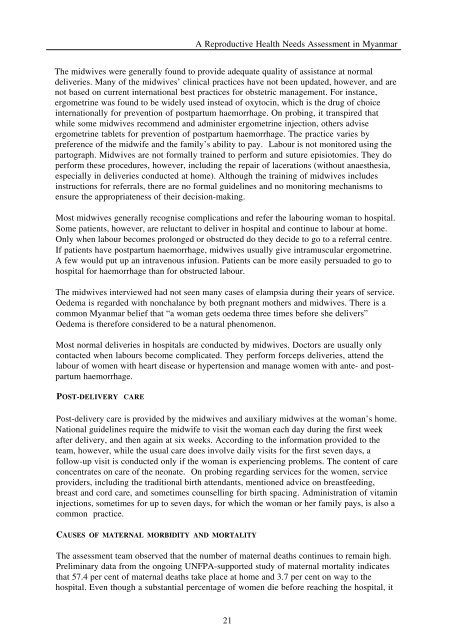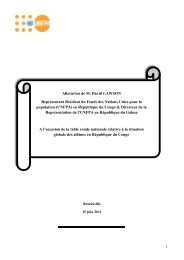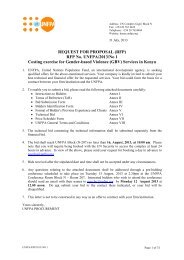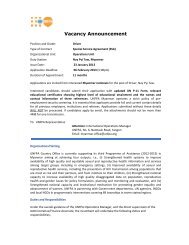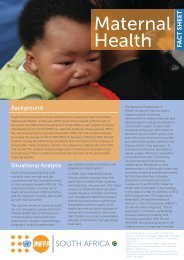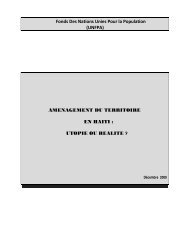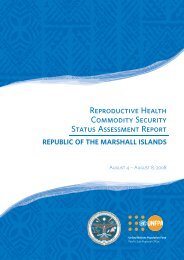A reproductive health needs assessment in Myanmar
A reproductive health needs assessment in Myanmar
A reproductive health needs assessment in Myanmar
You also want an ePaper? Increase the reach of your titles
YUMPU automatically turns print PDFs into web optimized ePapers that Google loves.
A Reproductive Health Needs Assessment <strong>in</strong> <strong>Myanmar</strong><br />
The midwives were generally found to provide adequate quality of assistance at normal<br />
deliveries. Many of the midwives’ cl<strong>in</strong>ical practices have not been updated, however, and are<br />
not based on current <strong>in</strong>ternational best practices for obstetric management. For <strong>in</strong>stance,<br />
ergometr<strong>in</strong>e was found to be widely used <strong>in</strong>stead of oxytoc<strong>in</strong>, which is the drug of choice<br />
<strong>in</strong>ternationally for prevention of postpartum haemorrhage. On prob<strong>in</strong>g, it transpired that<br />
while some midwives recommend and adm<strong>in</strong>ister ergometr<strong>in</strong>e <strong>in</strong>jection, others advise<br />
ergometr<strong>in</strong>e tablets for prevention of postpartum haemorrhage. The practice varies by<br />
preference of the midwife and the family’s ability to pay. Labour is not monitored us<strong>in</strong>g the<br />
partograph. Midwives are not formally tra<strong>in</strong>ed to perform and suture episiotomies. They do<br />
perform these procedures, however, <strong>in</strong>clud<strong>in</strong>g the repair of lacerations (without anaesthesia,<br />
especially <strong>in</strong> deliveries conducted at home). Although the tra<strong>in</strong><strong>in</strong>g of midwives <strong>in</strong>cludes<br />
<strong>in</strong>structions for referrals, there are no formal guidel<strong>in</strong>es and no monitor<strong>in</strong>g mechanisms to<br />
ensure the appropriateness of their decision-mak<strong>in</strong>g.<br />
Most midwives generally recognise complications and refer the labour<strong>in</strong>g woman to hospital.<br />
Some patients, however, are reluctant to deliver <strong>in</strong> hospital and cont<strong>in</strong>ue to labour at home.<br />
Only when labour becomes prolonged or obstructed do they decide to go to a referral centre.<br />
If patients have postpartum haemorrhage, midwives usually give <strong>in</strong>tramuscular ergometr<strong>in</strong>e.<br />
A few would put up an <strong>in</strong>travenous <strong>in</strong>fusion. Patients can be more easily persuaded to go to<br />
hospital for haemorrhage than for obstructed labour.<br />
The midwives <strong>in</strong>terviewed had not seen many cases of elampsia dur<strong>in</strong>g their years of service.<br />
Oedema is regarded with nonchalance by both pregnant mothers and midwives. There is a<br />
common <strong>Myanmar</strong> belief that “a woman gets oedema three times before she delivers”<br />
Oedema is therefore considered to be a natural phenomenon.<br />
Most normal deliveries <strong>in</strong> hospitals are conducted by midwives. Doctors are usually only<br />
contacted when labours become complicated. They perform forceps deliveries, attend the<br />
labour of women with heart disease or hypertension and manage women with ante- and postpartum<br />
haemorrhage.<br />
POST-DELIVERY CARE<br />
Post-delivery care is provided by the midwives and auxiliary midwives at the woman’s home.<br />
National guidel<strong>in</strong>es require the midwife to visit the woman each day dur<strong>in</strong>g the first week<br />
after delivery, and then aga<strong>in</strong> at six weeks. Accord<strong>in</strong>g to the <strong>in</strong>formation provided to the<br />
team, however, while the usual care does <strong>in</strong>volve daily visits for the first seven days, a<br />
follow-up visit is conducted only if the woman is experienc<strong>in</strong>g problems. The content of care<br />
concentrates on care of the neonate. On prob<strong>in</strong>g regard<strong>in</strong>g services for the women, service<br />
providers, <strong>in</strong>clud<strong>in</strong>g the traditional birth attendants, mentioned advice on breastfeed<strong>in</strong>g,<br />
breast and cord care, and sometimes counsell<strong>in</strong>g for birth spac<strong>in</strong>g. Adm<strong>in</strong>istration of vitam<strong>in</strong><br />
<strong>in</strong>jections, sometimes for up to seven days, for which the woman or her family pays, is also a<br />
common practice.<br />
CAUSES OF MATERNAL MORBIDITY AND MORTALITY<br />
The <strong>assessment</strong> team observed that the number of maternal deaths cont<strong>in</strong>ues to rema<strong>in</strong> high.<br />
Prelim<strong>in</strong>ary data from the ongo<strong>in</strong>g UNFPA-supported study of maternal mortality <strong>in</strong>dicates<br />
that 57.4 per cent of maternal deaths take place at home and 3.7 per cent on way to the<br />
hospital. Even though a substantial percentage of women die before reach<strong>in</strong>g the hospital, it<br />
21


